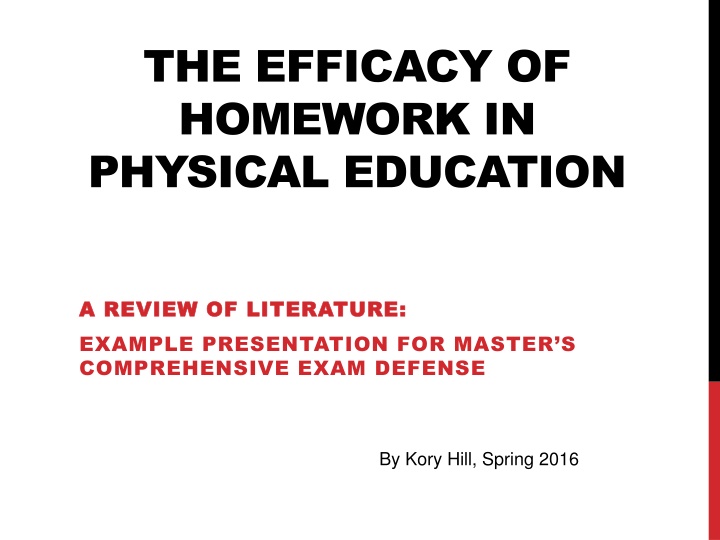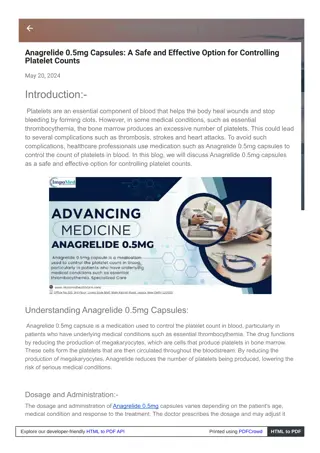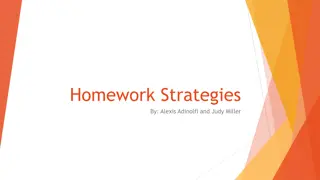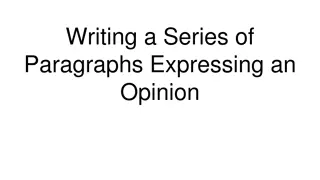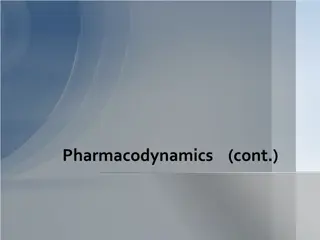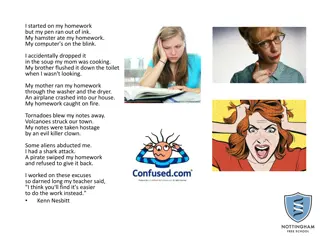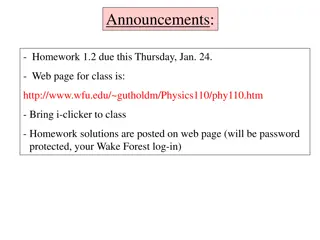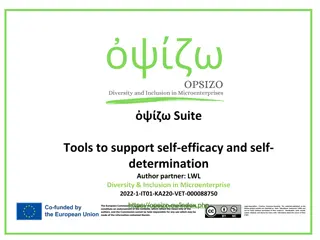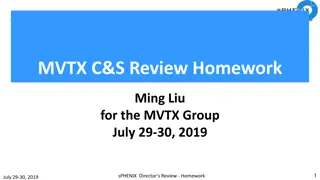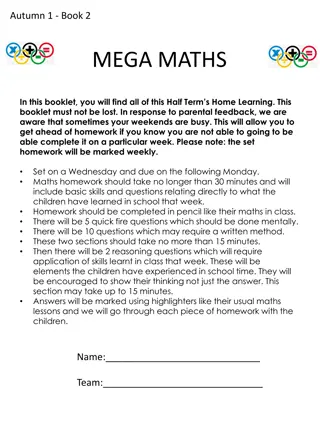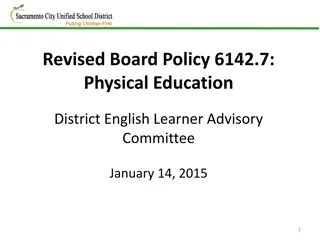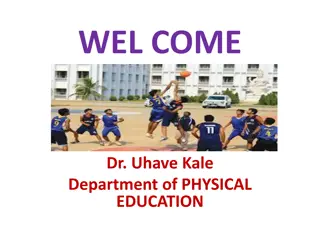The Efficacy of Homework in Physical Education: A Review
This review of literature explores the debate, reasons, and outcomes related to incorporating homework in physical education. It highlights the influence of homework on cognitive skills, physical activity promotion, and fitness behaviors. The study delves into the effectiveness of homework in enhancing learning outcomes in physical education settings and its impact on overall student engagement.
Download Presentation

Please find below an Image/Link to download the presentation.
The content on the website is provided AS IS for your information and personal use only. It may not be sold, licensed, or shared on other websites without obtaining consent from the author.If you encounter any issues during the download, it is possible that the publisher has removed the file from their server.
You are allowed to download the files provided on this website for personal or commercial use, subject to the condition that they are used lawfully. All files are the property of their respective owners.
The content on the website is provided AS IS for your information and personal use only. It may not be sold, licensed, or shared on other websites without obtaining consent from the author.
E N D
Presentation Transcript
THE EFFICACY OF HOMEWORK IN PHYSICAL EDUCATION A REVIEW OF LITERATURE: A REVIEW OF LITERATURE: EXAMPLE PRESENTATION FOR MASTER S COMPREHENSIVE EXAM DEFENSE By Kory Hill, Spring 2016
DEBATE The perceived value of homework has been influenced by political events (Gill & Schlossman, 2004; Maltese, Tai, & Fan, 2012). The debate continues today. See Alfie Kohn vs Harris Cooper ( Educational Leadership: Responding to Changing Demographics:The Case For and Against Homework, n.d.). Homework has not been viewed an important tool and in physical education and thus rarely studied (Mitchell et al., 2000; van Sluijs, McMinn, & Griffin, 2007).
WHY? Physical educators have suggested homework as a means of promoting PA outside of class and freeing up class time for PA and motor skill acquisition (Hill, 2009; Novak & Lynott III, 2015; St. Ours & Scrabis-Fletcher, 2013). Health promotion professionals report that many of the characteristics and outcomes of homework are likely to increase physical activity; PA is increased when there is: parental involvement choice encouragement of extracurricular participation acquisition of motor skills (Baranowski et al., 1997; Enright & O Sullivan, 2010; Strong et al., 2005).
LITERATURE SEARCH Three databases were searched for the years 2000-2016. In Google Scholar the words homework and physical education were used in a title search. When using SportDiscus and ProQuest, the same terms were used in abstract search. Google Scholar: 21 returns SportDiscus: 21 returns Proquest: 83 returns Excluded: Non-PE Exclusive to students with disabilities Secondary Sources Multiple approach interventions Reviewed: 17 Primary Sources identified
HOMEWORK FOR THE COGNITIVE DOMAIN Williams et al., 2013: H.S. (N= 175) mm strength/endurance preparation homework DV=written test, IV=trt (lecture, hw only, lecture + hw) All groups had equal levels of comprehension on post test Heesch et al., 2006: Sedentary Adults(N=244) taught cognitive strategies for increasing PA. DV=Process of change, self efficacy, Pros/Cons, IV trt (homework + pedometers) Those completing the homework were more likely to have higher POC and self-efficacy scores. Jorgenson & George, 2001: College students (N=291) in activity classes with infused fitness knowledge. DV=written test on fitness knowledge, IV=treatment (HW vs control) HW group had sign. Improvement on test Jenkins, 2006: College students (N=157) in activity classes with infused fitness knowledge. Qualitative design. 20% comments were HW+, 11% comments were HW-
PHYSICAL ACTIVITY AND FITNESS BEHAVIORS Increases PA Duncan et al., 2011: New Zealand 5th and 6th graders ( N=97) Pre-post school based intervention with homework Increase in PA as measured by pedometers Fairclough et al., 2013: 4th and 5th grade British children (N=318) Pre-post cross-curricular school based intervention with homework Treatment group showed a decrease in BMI & MPA as assessed by activity log; girls and obese students benefited most. Kriemler et al., 2010: Swiss 1st and 5th graders (N=802) Pre-post intervention that included homework Students in the treatment group showed increases in skinfold measures and MVPA as measured by accelerometer Claxton & Wells, 2009: U.S. University students (N=201) in wellness course. Pre-post homework only intervention Treatment group showed increase in mm strength and endurance activity and weight management activity; no difference in total PA as measured by activity log
TEACHERS AND PARENTS ATTITUDES AND PRACTICES Teachers Mitchell et al., 2000: Micheal et al., 2006 Thom & Yun, 2012 80% of U.S. in-service PE teachers (N=54) gave HW Mostly written and for make up work Part of CDC s SHPPS Representative sample (1194) of k-12 PE teachers in all 50 states 31% gave homework that involved the whole family Multiple regression identified three factors that influence decision to give PE homework: knowledge, attitude, expectations Burt et al., 2013 17% of PE teachers (N=144) reported giving homework Parents Piech et al., 2013 Preschooler in Poland (N=38) given homework (PA and play) to do with parents. 32% did not do the HW with children (66%-no time, 25%-not willing, 8%-forgot) Pantanowitz et al., 2011 95% of Israeli high school parents support the use of HW in PE
STUDENTS ATTITUDES AND PRACTICES Perceptions of the use of HW as a learning tool in PE: 54% H.S. students support 83% of H.S. view it as inappropriate Interviews showed HW was a major factor in curriculum resistance Qualitative data revealed students believe HW does not belong in PE not a real class. College students comments on HW for PE activity class: 65% positive and 35% negative. Complete HW assignments: 53% H.S. students did none 3-5 graders 22% completion by boys & 32% completion by girls Roughly 52% of HW submitted by H.S. students Only 6.9 % on PA homework was independent (teams, family, friends) Falsification of PA logs is common Low completion rates when not graded (Barney & Strand, 2008; Jenkins, Jenkins, Collums, & Werhonig, 2006; Kinchin & O Sullivan, 2003; Kriemler et al., 2010; Pantanowitz, Lidor, Nemet, & Eliakim, 2011; Smith, Cluph, & O connor, 2001; Smith & Madden, 2014)
CONCLUSIONS Support of Best Practices Accountability (Gabbei & Hamrick, 2001; Mitchell, Barton, & Stanne, 2000; Novak & Lynott III, 2015; St. Ours & Scrabis-Fletcher, 2013a) Family (Baranowski et al., 1997; Faber, Hodges Kulinna, & Darst, 2007; Williams & Hannon, 2013) Tied to objectives (Novak & Lynott III, 2015; Williams & Hannon, 2013) Teach others (Cutforth, 2000; Hill, 2009) Choice (Enright & O Sullivan, 2010; St. Ours & Scrabis-Fletcher, 2013b)
CONCLUSIONS Possible future research: 1. 2. Motor skill homework? Non health & fitness-related cognitive content? a) Sports rules and strategies b) Biomechanics What is the appropriate amount of Homework? Technology vs pen & paper for tracking PA? 3. 4.
